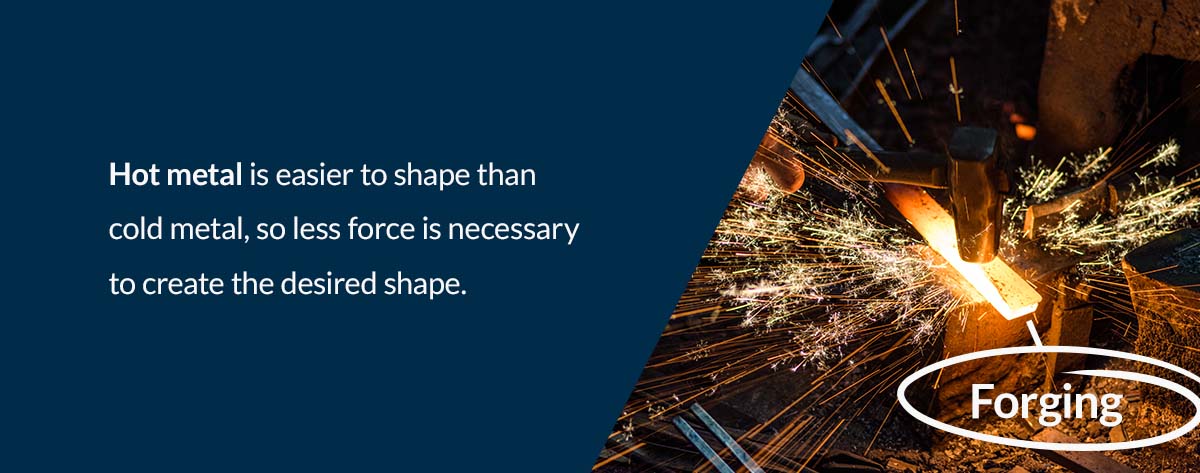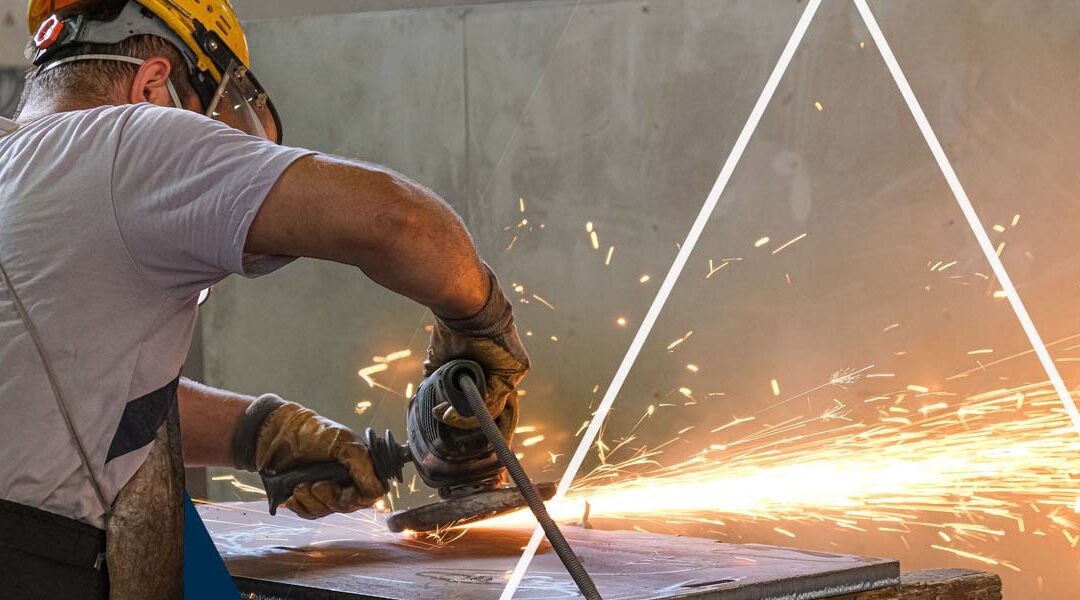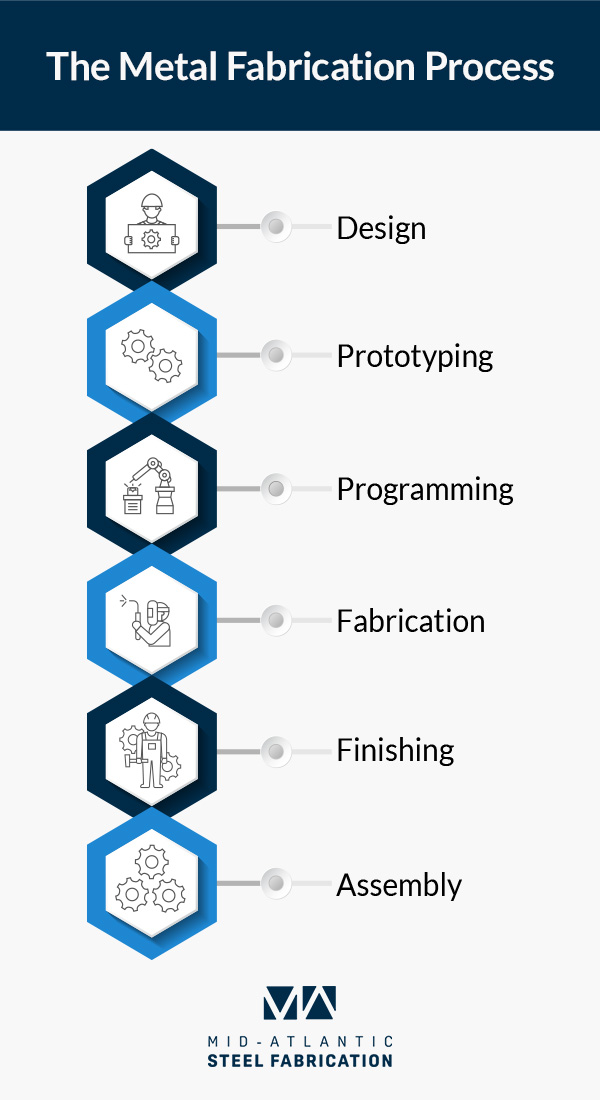Many of our everyday items rely on metal fabrication, from your car to your favorite chair to the device you’re reading this post on. This process is vital across industries and varies in complexity per project. Metal fabricators work with various raw materials and leverage techniques to produce vital metalwork across applications. Here, we’ll explore metal fabrication in more depth, including modern techniques, the types of fabrication available, and the factors that impact the fabrication process.
What Is Fabricated Metal?
Metal fabrication refers to the technique of creating metal objects by processing metals. Depending on the desired final product, metal fabrication can include one step or several. Fabricated metal has undergone processes like bending, machining, stamping, welding, forging, or forming to create a new material or product.
The History of Metal Fabrication
Despite our modern reliance on metal fabrication, the practice has deep roots in history. Even in ancient times, metal fabrication had a large impact on people’s lives. For example, hammering metal to make weapons or tools is an early type of metal fabrication that supported everyday life. Without these products, it would have been much harder to create shelter and secure food. While these early processes may seem to lack complexity, they created the foundation for modern practices.
The Industrial Revolution also played a large part in the growth of this practice. The introduction of mechanization and steam power allowed people to process metal in new ways. It was at this time that sheet metal work and forging evolved dramatically, and technologies like the rolling mill further revolutionized the field. Steam hammers and similar technologies made it possible to mass-produce the newly formed metal products, maximizing the technique’s impact. Fabricated metal aided the creation of skyscrapers, ships, bridges, locomotives, and many other items that helped create the world we know today.
At the turn of the 20th century, metal fabricators combined processes with innovations to create new processes like electric welding and tungsten inert gas welding. These new techniques enhanced metal product strength and allowed people to create products with more precision.
Metal fabrication continues to shape our lives. Modern metal fabricators leverage advanced technologies like computer numerical control (CNC) machining and computer-aided design (CAD) to create intricate products with high levels of precision. Modern techniques have also evolved to include processes like plasma and laser cutting. While the industry continues to adapt to new challenges and demands, there is no question that metal fabrication is crucial in our modern world.
What Is Metal Fabrication Today?
Modern metal fabrication generally falls into one of three categories, each referring to a different process function and scale within the fabrication process:
- Industrial: Industrial fabrication encompasses the processes of turning metal into industrial products. Metal fabricators in this sector generally work with parts and assemblies like plates or sheets to create metal products for industries like material handling, aerospace, water treatment, and more. Industrial fabricators typically create large-scale products like heavy machine parts, silos, and tanks.
- Structural: Construction and engineering teams rely on high-strength metals for some of the most common applications in the respective industries. Steel is most common for structural fabrication because it has an excellent strength-to-weight ratio and desirable properties for finished metalwork projects. Structural fabrication projects could include facility towers, industrial walkways, platforms for loading bays, and stairs in commercial and residential settings. Structural fabricators can also construct the components necessary to support a building’s framework, such as beams, trusses, and girders.
- Commercial: Commercial fabrication consists of forming the components and parts for public spaces like stores, municipal buildings, and restaurants. Completed metalwork projects could include products like shelving, appliances, guardrails, conveyors, and awnings. Commercial parts are often more precise and smaller than industrial or structural metalwork. A subsector of commercial fabrication is decorative fabrication, which involves creating products to enhance curbside appeal. For example, ornamental arches can enhance a building’s aesthetic but are not crucial to its integrity or the safety of workers and guests.
Understanding the Metal Fabrication Process
Fabricating metal involves several processes, from design to assembly. Regardless of the type of metal fabrication, most teams will leverage a similar fabrication process to complete metalwork. Even products that seem simple in nature often require multiple stages beyond shaping or cutting. The general fabrication process includes:
- Design: This initial phase involves refining and analyzing project requirements. It is especially crucial for custom projects, as unique requests can encounter obstacles or flaws that standard pieces do not. However, design is necessary for all projects because catching problems before mass production allows teams to minimize waste and meet project deadlines. Most modern teams will leverage CAD programs to guide designs and renderings.
- Prototyping: Prototyping allows fabricators to verify the function of a product before initiating large-scale production. Technologies like 3D printing and rapid sheet metal prototyping allow teams to create prototypes quickly and test functions. If a team identifies a flaw, the product will go back to the design phase for alterations. These first two phases will repeat as many times as necessary to ensure the longevity and function of the final product.
- Programming: Modern fabrication processes rely on innovative technologies and high-precision machines to create metalwork rapidly and with accuracy. Fabrication teams leverage computer-controlled machines to automate processes like turning, punching, and cutting. However, each machine requires programming to ensure correct dimensions, depth, and similar elements that will impact the final metal product.
- Fabrication: The fabrication stage refers to the actual techniques, such as folding, punching, cutting, shaping, and welding, to bring the design to life. Some metalwork projects may require various fabrication techniques, depending on the project’s complexity and functional demands.
- Finishing: Depending on the intended end-use of a product, teams may need to finish a product after fabrication. Finishing could include refining edges, smoothing surfaces, or applying powder coatings to meet project needs. This phase is optional for some metalwork projects. For example, some structural components may not require finishing because the appearance of the piece does not impact its capabilities. Alternatively, decorative metalwork for a building can benefit from finishing processes like painting or polishing.
- Assembly: A final stage of the fabrication process is assembly. While some metalwork projects may not require additional assembly, many common metalwork products do. Assembly involves processes like adding electrical integrations or welding to create a completed part or product. For example, automotive frames often require several metal components, like brackets and tubing, to undergo various fabrication techniques. Teams must then weld these components together for final assembly.
Metal Fabrication Techniques
Modern fabricators can create many types of products by leveraging different fabrication techniques. Some of the most common fabrication techniques include:
- Forming or bending: Bending or forming is the technique teams use to create components like bars, pipes, and tubes.
- Casting: When specific shapes are necessary, teams can use casting to ensure precision. For this technique, fabricators melt a metal at high temperatures and pour the liquefied substance into an empty mold. The metal fills the mold and cools in the shape of the cavity.
- Drawing: The drawing technique involves using tensile force to stretch metal. Drawing requires fabricators to pull metal through a die.
- Folding: Folding bends metal to a certain point. Typically, fabricators place the metal on a stationary die and use a tool to bend the material until it reaches the desired angle.
- Forging: This technique is one of the oldest forms of metal fabrication. Forging involves heating metal below its melting point to make it easier to alter. Hot metal is easier to shape than cold metal, so less force is necessary to create the desired shape.

- Cutting: Cutting is a simple fabrication technique that divides metal into several smaller pieces of desired lengths. Notching is a similar technique, but it does not divide the metalwork and instead creates cutouts on metalwork edges.
- Extrusion: This technique is similar to drawing and involves forcing metal through dies to create cross-sectional areas. It is common for creating bars and pipes.
- Machining: Machining allows fabricators to remove excess metal from a piece. Often, fabricators will use a wedge cutting tool to accomplish machining. Many people consider this a secondary fabrication technique for creating finishes.
- Welding: Welders fuse metals together at their joints. Most often, welding occurs by using electricity to create a high-temperature joint. However, there are many metal welding processes, and specific techniques vary by project need.
- Punching: Fabricators use punching techniques to create holes in sheets with high shearing force. Teams can adjust the punch size by using different objects to create the necessary forces to accomplish the punch. This technique allows fabricators to create holes in various sizes and shapes for decorative or functional purposes.
- Stamping: Stamping is a combination of bending and punching processes. This technique involves placing metal between two dies. The dies have specific shapes and use high force to mold the metal into the necessary shape.
- Shearing: Shearing allows fabricators to cut sheet metal with straight lines. Generally, this technique requires two blades, with one placed at the top of the metal and the other at the bottom. One blade is stationary, while the other moves through the sheet.
- Assembling: Assembly is generally the final stage of the fabrication process, so some may not consider it a specific technique. However, it is crucial for completing some metalwork projects. Teams can complete assembly through thread fastening, welding, using adhesives, and riveting.
Factors That Influence the Fabrication Process
With so many techniques available, it’s essential to consider which ones will most meet your needs. Several project elements will influence the fabrication processes and techniques you use. Consider these factors:
- Metal type: First and foremost, your material selection will impact the fabrication process. Metals have varying properties, like corrosion resistance, strength, and weight. Consider these properties to determine which technique will allow you to accomplish outcomes with ease. Additionally, the form you start with can dictate processes. For example, bars may be unsuitable for methods that sheet metals are ideal for.
- Material thickness: Some techniques are suitable for specific material thicknesses. For example, laser cutting is suitable for thin sheets, while thicker materials may need processes that utilize more force, such as bending.
- Complexity: Design considerations will always impact your process needs. Intricate designs often require specialized equipment and advanced fabrication techniques. Additionally, projects with tight tolerances may need more precise fabrication techniques.
- Volume: Production volume is another critical consideration. Understanding your needs and fabrication process capabilities is key to determining the most cost-effective and efficient techniques. High volumes are generally suitable for techniques like die casting, stamping, forming, automated welding, and forging. Low volumes that require high precision could benefit from processes like laser cutting or manual forming.

How Industries Benefit From Metal Fabrication
From mission-critical operations in medical fields to aiding the creation of the electronic devices we use to play our favorite games, metal fabrication drives many operations. Here’s a deeper look at some of the fabrication uses within some of the most well-known industries:
- Industrial: Industrial sectors can leverage metal fabrication techniques to manufacture custom components, steel supports, railings, pavilions, and complex parts.
- Aerospace: Aerospace sectors employ fabricators to create structural components, landing gear, engine components, and interior parts that enhance aircraft functionality.
- Architectural: Designers and architects commission fabricators to create custom functional and decorative metalwork like divider screens, arches, safety railings, and steel canopies.
- Residential: Contractors can rely on metal fabricators to achieve unique metalwork for residential buildings. Metal fabrication can achieve accents like stairways, wrought-iron driveway gates, railings, and more.
- Manufacturing: Manufacturers often need custom components to ensure optimal product performance and meet specific design needs.
- Automotive: Many automotive components require metal fabrication, including chassis and body components, functional interior pieces, exhaust systems, and aftermarket parts.
- Medical: Fabricators can create medical device enclosures, custom supply carts, hospital furniture, and more to enhance patient safety and comfort.
- Electronics: Metal fabrication can produce enclosures to protect sensitive electronic components, forge components to ensure reliable connections, prevent overheating by creating heat sinks, and more.
- Agriculture: Farmers and other teams in the agricultural industry rely on livestock handling, farming, and irrigation equipment. This equipment requires metal components to ensure durability, reliability, and efficiency.
Start Your Fabrication Project With Mid-Atlantic Steel Fabrication
At Mid-Atlantic Steel Fabrication, you can find premium fabrication services, from cutting to coating. The team at MA Steel Fab possesses the specialized skills you need for custom projects and the experience to deliver peace of mind. When you partner with us, you can expect seamless communication, personalized services, and superior craftsmanship with every project. Whether you need to mass produce components for mission-critical operations or require high precision for complex projects, we can help you achieve outstanding results. Request a quote to discover how we can meet your project needs.


